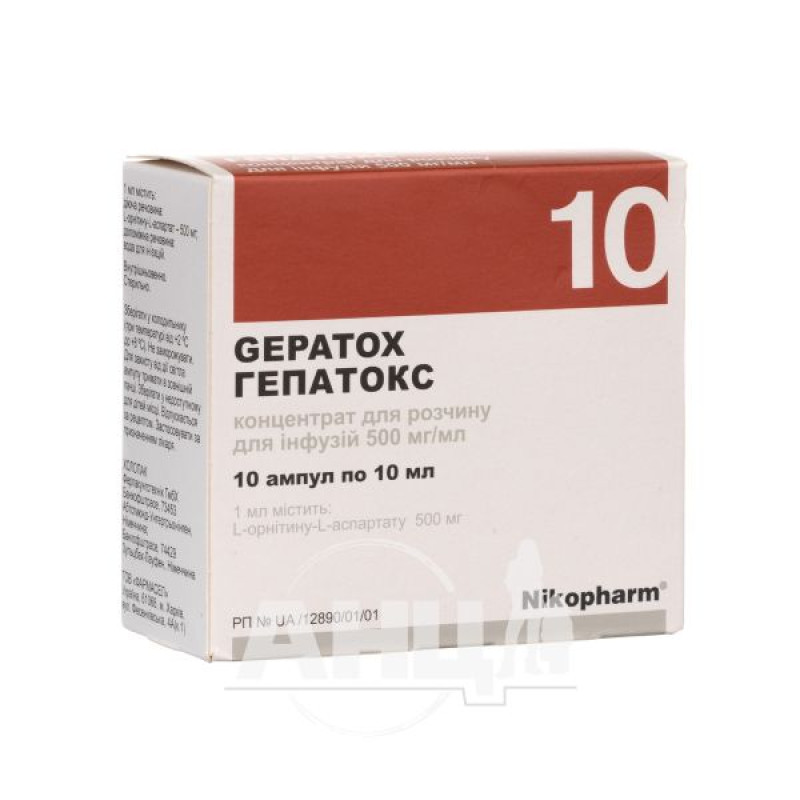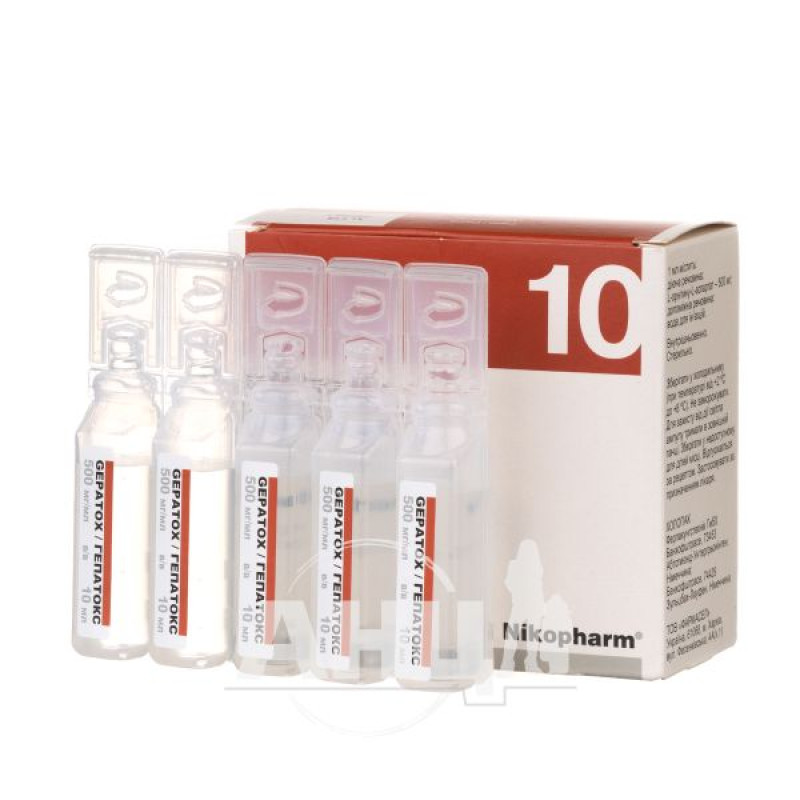Hepatox concentrate for infusion solution 500 mg/ml ampoule 10 ml No. 10

Instructions for use Hepatox concentrate for solution for infusion 500 mg/ml ampoule 10 ml No. 10
Composition
active ingredient: L-ornithine-L-aspartate;
1 ml of concentrate contains L-ornithine-L-aspartate 500 mg;
excipient: water for injections.
Dosage form
Concentrate for solution for infusion.
Main physicochemical properties: clear colorless or yellowish liquid.
Pharmacotherapeutic group
Drugs used in liver diseases, lipotropic substances. Hepatotropic drugs. ATX code A05B A.
Pharmacological properties
Pharmacodynamics
In vivo, the action of L-ornithine-L-aspartate is mediated by the amino acids, ornithine and aspartate, through two key methods of ammonia detoxification: urea synthesis and glutamine synthesis.
Urea synthesis occurs in periportal hepatocytes, where ornithine acts as an activator of two enzymes: ornithine carbamoyltransferase and carbamoylphosphate synthetase, as well as a substrate for urea synthesis.
Glutamine synthesis occurs in perivenous hepatocytes. In particular, under pathological conditions, aspartate and dicarboxylate, including products of ornithine metabolism, are absorbed into the cells and used there to bind ammonia in the form of glutamine.
Glutamate is an amino acid that binds ammonia under both physiological and pathophysiological conditions. The resulting amino acid glutamine is not only a non-toxic form for ammonia excretion, but also activates the important urea cycle (intracellular glutamine metabolism).
Under physiological conditions, ornithine and aspartate do not limit urea synthesis.
Experimental animal studies have shown that the ammonia-lowering properties of L-ornithine-L-aspartate are due to increased glutamine synthesis. In some clinical studies, this improvement has been shown to be relative to branched-chain amino acids/aromatic amino acids.
Pharmacokinetics
The half-life of both ornithine and aspartate is short – 0.3-0.4 hours. A small part of aspartate is excreted in the urine unchanged.
Indication
Treatment of concomitant diseases and complications caused by impaired liver detoxification function (e.g., cirrhosis) with symptoms of latent or severe hepatic encephalopathy, especially impaired consciousness (precoma, coma).
Contraindication
Hypersensitivity to L-ornithine-L-aspartate.
Severe renal failure (creatinine level above 3 mg/100 ml is considered as an indicative value).
Special safety measures.
Hepatox, concentrate for infusion solution, should not be administered into an artery.
Interaction with other medicinal products and other types of interactions
Interaction studies have not been conducted. Interactions are unknown to date.
Application features
When administering high doses of Hepatox, it is necessary to monitor the level of urea in blood plasma and urine.
In case of impaired liver function, the infusion rate should be adjusted according to the individual patient's condition to prevent nausea and vomiting.
Ability to influence reaction speed when driving vehicles or other mechanisms
Due to the disease, the ability to drive or operate other machinery may be impaired during treatment with L-ornithine-L-aspartate, so such activities should be avoided during the treatment period.
Use during pregnancy or breastfeeding
There are no data on the use of Hepatox during pregnancy. Animal studies with L-ornithine-L-aspartate to study its toxic effects on reproductive function have not been conducted. Therefore, the use of Hepatox during pregnancy should be avoided.
However, if treatment with Hepatox during pregnancy is considered necessary for vital indications, the doctor should carefully weigh the ratio of the possible risk to the fetus/child and the expected benefit to the mother.
It is not known whether L-ornithine-L-aspartate passes into breast milk, therefore, the use of Hepatox should be avoided during breastfeeding.
Method of administration and doses
Administer intravenously.
Unless otherwise prescribed, up to 4 ampoules (40 ml) can be used per day.
In severe hepatic encephalopathy and in the case of precoma or coma, administer up to 8 ampoules (80 ml) within 24 hours, depending on the severity of the condition.
Before administration, add the contents of the ampoules to 500 ml of infusion solution (0.9% sodium chloride solution, 5% glucose solution, Ringer's solution), but do not dissolve more than 6 ampoules in 500 ml of infusion solution.
The maximum rate of administration of Hepatox is 5 g/h (corresponding to the contents of 1 ampoule).
The course of treatment is determined by the doctor depending on the patient's clinical condition.
Children
Experience in children is limited, so the drug should not be used in pediatric practice.
Overdose
To date, no signs of intoxication due to an overdose of L-ornithine-L-aspartate have been observed. Side effects may be exacerbated. In case of overdose, symptomatic treatment is recommended.
Adverse reactions
Gastrointestinal tract
Very rare (<1/10,000): nausea.
These symptoms are generally short-lived and do not necessarily require discontinuation of the drug. They disappear when the dose or rate of administration of the drug is reduced.
Allergic reactions are possible.
Expiration date
2 years.
Storage conditions
Store in a refrigerator (at a temperature of +2°C to +8°C). Do not freeze. Keep the ampoule in the outer carton to protect from light. Keep out of the reach of children.
Packaging
10 ml in ampoules, 10 ampoules in a package.
Vacation category
According to the recipe.
Producer
LLC "PHARMASEL", Ukraine.
There are no reviews for this product.
There are no reviews for this product, be the first to leave your review.
No questions about this product, be the first and ask your question.






